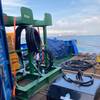Picture a precise navigation system with an overlaid electronic chart that includes an icon for every ship approaching and transiting the Panama Canal. Each icon provides the ship name, size of the ship, course and speed - information that improves safety and security, and will assist in the management of critical canal resources. The Panama Canal Authority (ACP) announced today the formal implementation of the Automatic Identification System (AIS) - a revolutionary navigation aid that will do just that. AIS is now required equipment for all vessels transiting the waterway.
Like a hawk flying high above relaying to each vessel what's coming and who's ahead, the AIS will be of great value to the ACP and shippers. Many of the challenges of navigating the Canal will be alleviated because Canal pilots will now be able to better view all traffic transiting through the Canal - and it will be particularly valuable in narrow passages and low-visibility situations. In addition, the ACP will be able to improve its management of the Canal's traffic flow and reduce the length of intervals between transiting ships.
The AIS works in real time and transmits data to all AIS-equipped ships or shoreside facilities within VHF radio range, providing Canal authorities with a complete and precise view of all traffic in the Panama Canal. Position and other data are distributed instantaneously from the ship's sensors into the AIS system, where it is formatted and transmitted in a short data burst on a dedicated VHF radio channel.
"I am very proud of our maritime operations personnel. Their tenacity in getting this system up and running - considerably ahead of schedule - shows their dedication to continue to improve safety, security and waterway operations. Canal safety, reliability and efficiency are our top priorities and we will continue to look for other cutting-edge technologies that help us serve our customers," said Canal Administrator, Alberto Alemán Zubieta.
The AIS automatically identifies a ship, type, position, course, speed, navigational status and other safety-related information through new software located onboard and onshore. All ships transiting Canal waters over 300 net tons or more than 20 meters in length must now be equipped with an AIS system that meets the standards set by the International Maritime Organization (IMO). With regard to combined and multiple units (tug and tows), only the tug will be required to be equipped with and AIS.
The Canal implementation of AIS is well ahead of the 2004 IMO deadline. According to the International Convention for the Safety of Life at Sea (SOLAS), all vessels will be required to carry AIS systems effective on the date of the first safety equipment survey between July 1, 2004 and December 31, 2004. Between Panama Canal Authority's July 1, 2003 implementation date and the dates required by SOLAS, for those vessels not yet carrying AIS, the Panama Canal will provide portable AIS vessel tracking units for a fee of $150.00.
Other recently implemented ACP safety measures include the modification of the pre-arrival notification period. Vessels approaching the Panama Canal must now communicate with the ACP no less than 96 hours in advance of arrival in the Canal.
The previous pre-arrival notification period was 48 hours.
Featured videos

Inmarsat Enhances Service to Drive Digitalization

Tracking Foreign Vessels Working in the U.S. Jones Act Market

Unlock Onboard Data Efficiencies
Subscribe for
Maritime Reporter E-News
Maritime Reporter E-News is the maritime industry's largest circulation and most authoritative ENews Service, delivered to your Email five times per week









